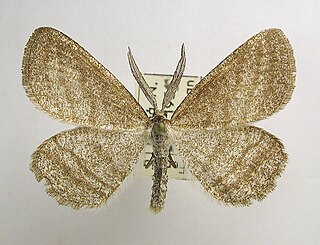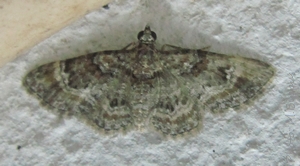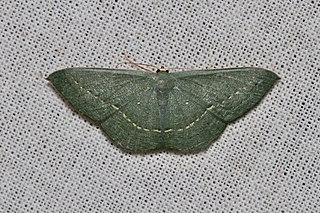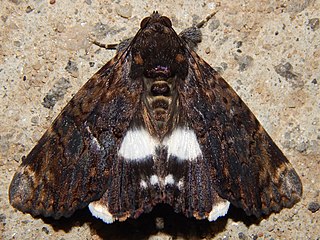A common classification of the Lepidoptera involves their differentiation into butterflies and moths. Butterflies are a natural monophyletic group, often given the suborder Rhopalocera, which includes Papilionoidea, Hesperiidae (skippers), and Hedylidae. In this taxonomic scheme, moths belong to the suborder Heterocera. Other taxonomic schemes have been proposed, the most common putting the butterflies into the suborder Ditrysia and then the "superfamily" Papilionoidea and ignoring a classification for moths.

The Sphingidae are a family of moths commonly called sphinx moths, also colloquially known as hawk moths, with many of their caterpillars known as hornworms. It includes about 1,450 species. It is best represented in the tropics, but species are found in every region. They are moderate to large in size and are distinguished among moths for their agile and sustained flying ability, similar enough to that of hummingbirds as to be reliably mistaken for them. Their narrow wings and streamlined abdomens are adaptations for rapid flight. The family was named by French zoologist Pierre André Latreille in 1802.

The geometer moths are moths belonging to the family Geometridae of the insect order Lepidoptera, the moths and butterflies. Their scientific name derives from the Ancient Greek geo γεω, and metron μέτρον "measure" in reference to the way their larvae, or inchworms, appear to measure the earth as they move along in a looping fashion. Geometridae is a very large family, containing around 23,000 described species; over 1400 species from six subfamilies are indigenous to North America alone. A well-known member is the peppered moth, Biston betularia, which has been the subject of numerous studies in population genetics. Several other geometer moths are notorious pests.

The feathered thorn is a moth of the family Geometridae. It was first described by Carl Linnaeus in 1761.

Perconia strigillaria, the grass wave, is a moth of the family Geometridae. The species was first described by Jacob Hübner in 1787. It can be found in Europe, east to the Urals, Asia Minor and China's Tarbagatai Mountains.

Cleorodes is a monotypic moth genus in the family Geometridae described by Warren in 1894. Its single species, Cleorodes lichenaria, the Brussels lace, was first described by Johann Siegfried Hufnagel in 1767.

Gymnoscelis, the pugs, is a large genus of moths in the family Geometridae described by Paul Mabille in 1868.

Luxiaria is a genus of moths in the family Geometridae first described by Francis Walker in 1860.
Scardamia is a genus of moths in the family Geometridae.

Cleora cinctaria, the ringed carpet, is a moth of the family Geometridae. The species was first described by Michael Denis and Ignaz Schiffermüller in 1775. It is found from Europe to southern Siberia, Turkey, the Caucasus, central Asia and Mongolia. It is also found in Japan.

Aspitates gilvaria, the straw belle, is a moth of the family Geometridae. The species was first described by Michael Denis and Ignaz Schiffermüller in 1775. It is found from Europe to the eastern part of the Palearctic realm. The main habitats are warm slopes, heathlands, fields and abandoned quarries. In the mountains, the species rises to heights of 1000 meters. Adults are on wing from July to August.
Louis Beethoven Prout (1864–1943) was an English entomologist and musicologist.

Orothalassodes falsaria is a species of moth of the family Geometridae. It is found in north-eastern India, Sri Lanka, China, Peninsular Malaysia, Sumatra, Borneo, Java and Bali. Records from Taiwan are misidentifications of Orothalassodes pervulgatus.
Psilocerea anearia is a species of moth of the family Geometridae first described by Charles Swinhoe in 1904. It is found on Madagascar.

Traminda obversata is a species of moth of the family Geometridae. It is found in Africa south of the Sahara and on the islands of the Indian Ocean.
Epigelasma crenifera is a species of moth of the family Geometridae. It is found in North Madagascar.
Archichlora alophias is a species of moth of the family Geometridae. It is found in central Madagascar, often near Antananarivo.
Heterorachis asyllaria is a species of moth of the family Geometridae first described by Charles Swinhoe in 1904. It is found on Madagascar.

Nagia linteola is a species of moth in the family Erebidae first described by Achille Guenée in 1852. This species occurs in South Africa, the Democratic Republic of the Congo, Yemen, the Comoros, Mauritius, Madagascar, Indonesia (Borneo), India, Sri Lanka, Myanmar, Thailand and in Australia, where it has been recorded from Western Australia, the Northern Territory, Queensland and Victoria.

Zoosphaerium darthvaderi, also known as the Darth Vader giant pill millipede, is a species of giant pill millipede endemic to the island state of Madagascar. It is named after the Star Wars character Darth Vader. The millipede is restricted to the Ambohitantely Reserve and is considered an extremely endangered species.












